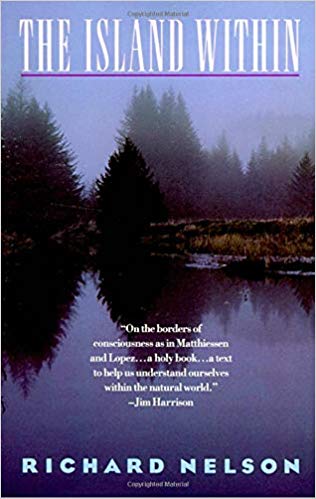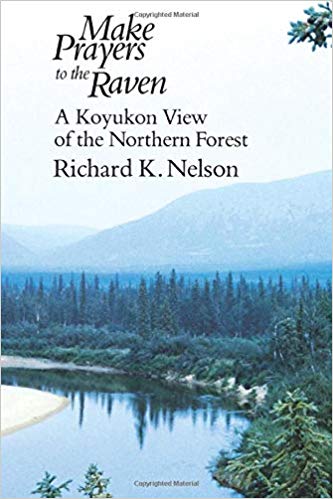By Scott Slovic, University of Idaho, ISLE Editor
Richard K. Nelson, known to his many friends in community of environmental writers as “Nels,” died on November 4, 2019, having asked that he spend his final minutes, after being taken off of life support, listening to the recorded sound of ravens. For those familiar with Nels’s life and work, such a request was fully in keeping with his tremendous passion for the natural world, especially for animals, and most especially for ravens and other animals he knew well from many decades of living in Sitka, Alaska. Born in Madison, Wisconsin, on December 1, 1941, Nels earned his B.S. and M.S. in anthropology at the University of Wisconsin and his Ph.D. in anthropology at the University of California, Santa Barbara. Nels first began to live among the Eskimo hunting communities in Alaska as a master’s student at Wisconsin in 1964, eventually producing the book Hunters of the Northern Ice (1969). He later published such works as Shadow of the Hunter: Stories of Eskimo Life (1980) and Make Prayers to the Raven: A Koyukon View of the Northern Forest (1983).
 During the 1980s, Nels’s writing became increasingly literary, though it was always anchored in philosophical views he learned from his native teachers in Alaska, particularly the Koyukon people. I first became familiar with his work from the stunning essay titled “The Gifts,” which appeared in the Autumn 1986 issue of Antaeus, a volume that helped to inspire the nascent field of nature writing studies and contributed directly to the eventual founding of ASLE in 1992. “The Gifts,” which appeared again three years later as the chapter “The Gifts of Deer” in The Island Within (1989—winner of the John Burroughs Medal for outstanding natural history writing in 1991), is an essay about hunting, but it also reveals the author’s profound affinity for deer and his respect for their gifts on many other levels. After taking a deer, he writes beautifully of the “incompatible emotions” he feels: “It’s always this way: the sudden encounter with death, the shock that overrides the cushioning of the intellect. I force away the sadness and remember that death is the spark that keeps life itself aflame: these deer we eat from, and the fish, and the plants that die to feed us” (263). In a strange way, the news of the author’s own death comes as a shock to many of us who knew and loved him. He was a supremely energetic and joyful person, always punctuating his eloquent readings and lectures with tongue-twisting phrases in Koyukon and bursts of laughter.
During the 1980s, Nels’s writing became increasingly literary, though it was always anchored in philosophical views he learned from his native teachers in Alaska, particularly the Koyukon people. I first became familiar with his work from the stunning essay titled “The Gifts,” which appeared in the Autumn 1986 issue of Antaeus, a volume that helped to inspire the nascent field of nature writing studies and contributed directly to the eventual founding of ASLE in 1992. “The Gifts,” which appeared again three years later as the chapter “The Gifts of Deer” in The Island Within (1989—winner of the John Burroughs Medal for outstanding natural history writing in 1991), is an essay about hunting, but it also reveals the author’s profound affinity for deer and his respect for their gifts on many other levels. After taking a deer, he writes beautifully of the “incompatible emotions” he feels: “It’s always this way: the sudden encounter with death, the shock that overrides the cushioning of the intellect. I force away the sadness and remember that death is the spark that keeps life itself aflame: these deer we eat from, and the fish, and the plants that die to feed us” (263). In a strange way, the news of the author’s own death comes as a shock to many of us who knew and loved him. He was a supremely energetic and joyful person, always punctuating his eloquent readings and lectures with tongue-twisting phrases in Koyukon and bursts of laughter.
He was a champion of many causes, writing passionately in defense of the Tongass National Forest in Alaska and leveling searing criticism at our oil-addicted society in the op-ed “Oil and Ethics: Adrift on Troubled Waters,” which he published in the Los Angeles Times following the Exxon Valdez oil spill. His 1997 book, Heart and Blood: Living with Deer in America, explores the cultural and ecological meaning of deer in our society, exemplifying Nels’s ability to combine thoughtful research with mystical attachment to his subject matter. “I sometimes wonder if I should walk outside each morning and touch the earth,” he wrote in The Island Within, “to be sure it is still there, still living. Perhaps all peoples have felt a similar fear, and have recognized through it their dependence on the nurturing and vitality of nature. Certainly, this is the founding wisdom of the Koyukon elders” (86). His was a deeply necessary voice during the rise of environmental writing as a prominent force in American culture. He routinely joined fellow writers, such as Robert Michael Pyle, Gary Paul Nabhan, Rick Bass, Terry Tempest Williams, and other kindred spirits, in literary barnstorming tours organized by the Orion Society in the 1990s under the name “The Forgotten Language,” bringing a passion for language and the more-than-human world to many communities across the United States. When a biking injury in the early 2000s made it difficult for him to sit still at a keyboard for long periods of time, he transitioned from writing to making audio programs about animals and other ecological topics for radio, and these are now available at www.encountersnorth.org.
 I will always remember Nels as a uniquely exuberant soul, in love with the many communities he belonged to, human and otherwise. In the introduction to Make Prayers to the Raven, he recalls being alone with his dog team near Moosehorn Lake on a cold Arctic morning when a raven landed on a nearby spruce tree. After living with the Koyukon people for many months, Nels had begun to lose his Western detachment from other species and “feel the further dimension in nature that was so preeminently important” to his native teachers. “Ravens,” he writes, “had become more than just beautiful and intelligent birds. I found myself watching them and feeling watched in return…watched by something more than the ravens’ gleaming black eyes. I found myself listening to their calls, not just to their strange ventriloqual gurglings but also to hear what they might be saying” (xiii). After looking around self-consciously to make sure he was alone—with his dogs and the raven—the author shouted, “Tseek’aal [Old Grandfather], bring me luck!” Then he looked around as his words “echoed into the surrounding forest” (xiv). Nels himself brought good fortune, beauty, laughter, and friendship into the lives of many in the ASLE community. We will miss him.
I will always remember Nels as a uniquely exuberant soul, in love with the many communities he belonged to, human and otherwise. In the introduction to Make Prayers to the Raven, he recalls being alone with his dog team near Moosehorn Lake on a cold Arctic morning when a raven landed on a nearby spruce tree. After living with the Koyukon people for many months, Nels had begun to lose his Western detachment from other species and “feel the further dimension in nature that was so preeminently important” to his native teachers. “Ravens,” he writes, “had become more than just beautiful and intelligent birds. I found myself watching them and feeling watched in return…watched by something more than the ravens’ gleaming black eyes. I found myself listening to their calls, not just to their strange ventriloqual gurglings but also to hear what they might be saying” (xiii). After looking around self-consciously to make sure he was alone—with his dogs and the raven—the author shouted, “Tseek’aal [Old Grandfather], bring me luck!” Then he looked around as his words “echoed into the surrounding forest” (xiv). Nels himself brought good fortune, beauty, laughter, and friendship into the lives of many in the ASLE community. We will miss him.
